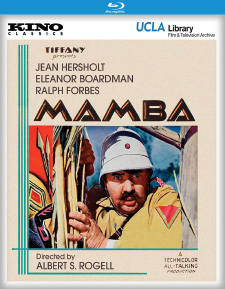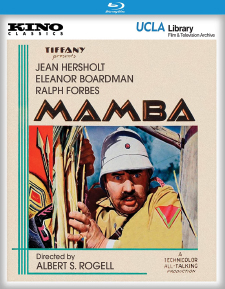Mamba (1930) (Blu-ray Review)

Director
Albert S. RogellRelease Date(s)
1930 (May 10, 2022)Studio(s)
Color Art Productions/Tiffany Pictures (Kino Classics)- Film/Program Grade: C
- Video Grade: B-
- Audio Grade: C
- Extras Grade: B+
- Overall Grade: A-
Review
Mamba is an ambitious if problematic pre-Code melodrama that was one of the earliest all-talking, all-color features in film history. It was also considered lost for many decades, as the original negatives were probably incinerated by MGM while shooting the burning of Atlanta for Gone with the Wind. (Since nitrate stocks burned easily, they made good fuel, regardless of their historical value.) All that was known to exist were a few print reels, as well as a set of the original audio discs. Fortunately, a couple of Australian collectors held a nearly complete silent print, and in 2016, the film and the audio were reunited at last. Mamba had been resurrected from the dead.
Mamba was a production of Tiffany Pictures, which was a Poverty Row studio known for extremely low-budget productions. Yet they pulled out all the stops for Mamba, spending approximately $500,000 on the film, which was many times higher than any of their previous budgets. That strained the studio to its limits, and budgetary problems ended up shortening the shooting schedule, with creditors nipping at the production’s heels the whole time. Yet director Albert S. Rogell still managed to pull everything together, even though there are some obvious ellipses that were likely the result of not having enough time or money to shoot everything.
The screenplay for Mamba is credited to Tim Miranda and Winifred Dunn, based on a story by Ferdinand Schumann-Heink and John Reinhardt. Their tale revolves around August Bolte (Jean Hersholt), a wealthy but boorish German plantation owner in East Africa at the advent of World War I. There’s an uneasy comity between the German and British troops in the area, and while Bolte longs to be accepted by both sides, neither want anything to do with him. He tries to increase his social status by arranging a marriage to Helen von Linden (Eleanor Boardman), essentially buying her services by paying off her father’s debts. That only worsens his situation when Helen becomes attracted to a German officer (Ralph Forbes). Tensions flare, before a native uprising intervenes, and worse, a state of war is declared between Germany and Great Britain.
The restoration of Mamba opens with this new title card:
“This film contains racism and/or the mistreatment of people or cultures. Such depictions, in any era, are inexcusable. The film is being presented in its original form to bear witness to the history of racism in cinema, and to encourage a dialogue about how a future cinema can become more inclusive.”
While it’s certainly true that all works of art are products of their times, some have dated worse than others, and the racial elements in Mamba are particularly unpleasant. They’re distasteful enough that they really do deserve a disclaimer up front. Yet there’s no denying the fact that Mamba is still an important part of film history, even if it’s an unfortunate reminder of some of the regrettable aspects of that history. All films are worthy of preservation, good, bad, or ugly, and Mamba is no exception.
Cinematographer Charles P. Boyle shot Mamba in 35 mm two-color Technicolor System 3, using spherical lenses, framed at 1.37:1 for its sound-on-disc theatrical release. Early Technicolor films are often referred to as two-strip Technicolor, but that’s not really accurate. The cameras were actually loaded with a single roll of film, and the red and green elements were recorded on alternating frames. Separate prints were then generated from the negative, and recombined into a single release print. Earlier versions cemented the two prints together, but by System 3, they were combined into a single strip via dye transfer. (That’s a gross oversimplification, but it should still give a taste of what was involved.)
The preservation work on this Kino release was handled by the UCLA Film & Television Archive, with The Film Foundation, using both Fotekem and Pacific Title & Art Studio. Funding was provided by The George Lucas Family Foundation and the Franco-American Cultural Fund (the latter consisting of the MPAA, The Director’s Guild, and the Writer’s Guild West, along with the Society of Authors, Composers, and Music Publishers). The Australian print was missing one scene that had been deleted by Australian censors because of its suggestive content, so it had to be recreated via stills that play over the uncut audio from the discs.
The fact that Mamba exists at all anymore is a minor miracle, so it’s easier to forgive any deficiencies in the results. If anything, this film should be graded on a curve, so don’t read too much into the score shown above. There are density fluctuations throughout, with persistent scratches and other damage, as well as occasional dropped frames. The registration from the printing process wasn’t always perfect, so there’s some color fringing and bleeding. The whole thing bears the distinctively unnatural look of two-color Technicolor—the flesh tones aren’t accurate, but then again, they never were. All of those issues are baked into the source elements. The only slight problem with this release is that the contrast sometimes runs a little hot, and the grain in the brighter areas can break up into noise—it’s especially noticeable on the whites of the German uniforms. Short of an expensive frame-by-frame restoration, however, Mamba simply isn’t going to look much better than it does here.
Audio is offered in English 2.0 mono LPCM, with optional English SDH subtitles. The restoration work on the audio was performed by Audio Mechanics, along with DJ Audio, Inc. and Simon Daniel Sound, working from the original 33-1/2 RPM audio discs. They did fine work, within the limitations of the original recordings. The fidelity is understandably quite restricted, and there’s still audible background noise. The biggest issue is that the dialogue can sound muffled and it’s sometimes difficult to understand, but again, that’s inherent to the original production. (This is one case where the optional subtitles can come in handy.)
The following extras are included:
- Audio Commentary by Brian Trenchard-Smith
- Interview with Paul Brennan (HD – 7:40)
- Theatre of Dreams (Upscaled HD – 7:36)
- Slideshow (HD – 31 in all – 5:11)
Legendary Australian filmmaker Brian Trenchard-Smith provides a well-researched and detailed commentary for Mamba. He discusses the cast and crew, especially Hersholt, as well as covering historical and technical information. While he does rightly criticize the racial insensitivity in the film, he makes a persuasive argument that it still intentionally demonstrates the negative impacts of colonialism. He also finds a critique of the patriarchal treatment of women in the abusive treatment of Helen by Bolte, which he attributes to the social conscience of co-writer Winifred Dunn. He offers praise for Albert S. Rogell ‘s staging, especially the lengthy tracking shot that opens the film, while also pointing out other shots that Rogell should have gotten, but didn’t. It’s always fun to hear a filmmaker analyze another director’s work, and Trenchard-Smith is one of the best at doing so.
The interview with Paul Brennan is actually a deleted scene from the documentary Splice Here: A Projected Odyssey, in rough assembly form. Brennan (with contributions by Mike Trickett) gives a brief history of Tiffany Pictures, and tells the story of the Australian print. Theatre of Dreams features Murray and Pat Matthews, the collectors who held that print, along with their daughter Amanda. They discuss how they couldn’t get anyone interested in it until Paul Brennan found out about it (be sure to visit the Additional Notes section below for an update on this). Theatre of Dreams also gives glimpses of their impressive collection of vintage projectors and other film-related equipment. The Slideshow adds more history of the production and its restoration, as well as behind-the-scenes materials.
As a film, Mamba may be little more than a curio, but as a historical document, it’s invaluable. At this point, it’s the oldest surviving all-talking, all-color film. Kino Lorber deserves the highest praise for releasing a Blu-ray like this, which is unlikely to recoup their production costs. They also deserve support for doing so. If you have even the slightest interest in film preservation, please add Mamba to your collection. It’s too rare of an opportunity to pass up.
- Stephen Bjork
(You can follow Stephen on social media at these links: Twitter and Facebook.)
Additional Notes
Paul Brennan reached out to inform us that sadly, Murray and Pat Matthews both passed away last week within a few days of each other. Their love of movies, and especially their love of the film medium itself, is what saved Mamba from obscurity. Having Mamba available on Blu-ray is a worthy legacy for them, and their passing is yet another reason why fellow lovers of film should add this disc to their collections.

